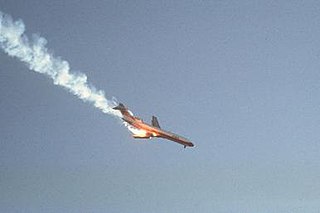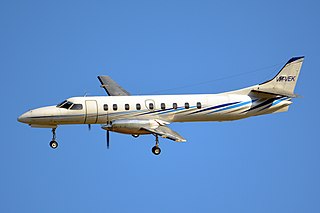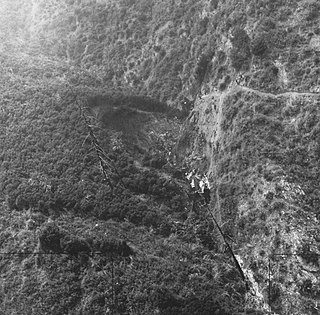Northwest Airlink was the brand name of Northwest Airlines' regional airline service, which flew turboprop and regional jet aircraft from Northwest's domestic hubs in Minneapolis, Detroit, and Memphis. Service was primarily to small-to-medium-sized cities and towns where larger aircraft might not be economical to operate and also to larger markets to either provide additional capacity or more frequent flights than could be justified using mainline aircraft. The Northwest Airlink trade name was replaced by the Delta Connection trade name for Delta Air Lines following the Delta/Northwest merger.

Pacific Southwest Airlines Flight 182 was a scheduled flight on September 25, 1978, by Pacific Southwest Airlines (PSA), from Sacramento to San Diego (SAN), with a stopover at Los Angeles (LAX). The aircraft serving the flight, a Boeing 727-214, collided mid-air with a private Cessna 172 over San Diego. It was Pacific Southwest Airlines' first fatal accident, and it remains the deadliest air disaster in California history. At the time, it was the deadliest air crash to occur in the United States, and remained so until the crash of American Airlines Flight 191 in May 1979.
This is a list of aviation-related events from 1974. 1974 had been deemed as "the single worst year in airline history" although this has since been surpassed.
This is a list of aviation-related events from 1975.
This is a list of aviation-related events from 1976.

Air Midwest Flight 5481 was a Beechcraft 1900D on a regularly scheduled passenger flight from Charlotte Douglas International Airport in Charlotte, North Carolina, to Greenville–Spartanburg International Airport in Greer, South Carolina. On the morning of January 8, 2003, the Beechcraft stalled while departing Charlotte Douglas International Airport and crashed into an aircraft hangar, killing all 21 passengers and crew aboard and injuring one person on the ground.

San Luis Obispo County Regional Airport, McChesney Field is a civil airport near San Luis Obispo, California, United States. Five passenger airlines serve the airport with nonstop flights to eight cities: Dallas-Fort Worth, Denver, Las Vegas, Los Angeles, Phoenix, Portland, San Diego, San Francisco and Seattle. The airport was established in 1939 and used by the U.S. military between 1939 and 1945.

The Beechcraft 1900 is a U.S made twin-engine turboprop regional airliner manufactured by Beechcraft. It is also used as a freight aircraft and corporate transport, and by several governmental and military organizations. With customers favoring larger regional jets, then-owner Raytheon ended production in October 2002.

The Fairchild Swearingen Metroliner is a 19-seat, pressurized, twin-turboprop airliner first produced by Swearingen Aircraft and later by Fairchild Aircraft at a plant in San Antonio, Texas.

The Beechcraft Model 99 is a civilian aircraft produced by Beechcraft. It is also known as the Beech 99 Airliner and the Commuter 99. The 99 is a twin-engine, unpressurized, 15 to 17 passenger seat turboprop aircraft, derived from the earlier Beechcraft King Air and Queen Air. It uses the wings of the Queen Air, the engines and nacelles of the King Air, and sub-systems from both, with a specifically designed nose structure.

Trans World Airlines (TWA) Flight 553 was a McDonnell Douglas DC-9-15 jet airliner, registration N1063T, operated by Trans World Airlines on March 9, 1967 between Pittsburgh, Pennsylvania and Dayton, Ohio. While descending toward Dayton about 29 miles from the airport, the aircraft collided in midair with a Beechcraft Baron, a small, general-aviation airplane, near Urbana, Ohio. All 25 aboard the DC-9 and the sole occupant of the Beechcraft were killed.

Cubana de Aviación Flight 493, registration CU-T188, was a Douglas DC-4 en route from Miami, Florida, to Havana, Cuba, on April 25, 1951. A US Navy Beechcraft SNB-1 Kansan, BuNo 39939, was on an instrument training flight in the vicinity of Naval Air Station Key West, Florida, at the same time. The two aircraft collided in mid-air over Key West, killing all 43 aboard both aircraft.

Hughes Airwest Flight 706 was a regularly scheduled flight operated by American domestic airline Hughes Airwest from Los Angeles, California to Seattle, Washington, with several intermediate stops. On Sunday, June 6, 1971, the McDonnell Douglas DC-9 serving as Flight 706 departed Los Angeles just after 6 p.m. en route to Seattle as a McDonnell Douglas F-4 Phantom II of the United States Marine Corps was approaching Marine Corps Air Station El Toro near Irvine at the end of a flight from Naval Air Station Fallon in Nevada. The two aircraft collided in midair over the San Gabriel Mountains near Duarte, killing all 49 aboard the DC-9 and the F-4 pilot; the F-4 radar intercept officer ejected and survived.

The Grand Canyon mid-air collision occurred in the western United States on June 30, 1956, when a United Airlines Douglas DC-7 struck a Trans World Airlines Lockheed L-1049 Super Constellation over Grand Canyon National Park, Arizona. The first plane fell into the canyon while the other slammed into a rock face. All 128 on board both airplanes perished, making it the first commercial airline incident to exceed one hundred fatalities. The airplanes had departed Los Angeles International Airport minutes apart from each other and headed for Chicago and Kansas City, respectively. The collision took place in uncontrolled airspace, where it was the pilots' responsibility to maintain separation. This highlighted the antiquated state of air traffic control, which became the focus of major aviation reforms.
Wings West Airlines was an American regional airline headquartered at McChesney Field (SBP), unincorporated San Luis Obispo County, California. The airline initially began scheduled passenger service as an independent commuter air carrier and then subsequently became an American Eagle affiliate of American Airlines operating turboprop aircraft on code sharing flights on behalf of American.

American Airlines Flight 910, a four-engine Douglas DC-6 propliner, collided in mid-air with a single engine Temco Swift on final approach to Dallas Love Field on June 28, 1952, over Dallas, Texas. The DC-6 was carrying 55 passengers and 5 crew members from San Francisco, California. The DC-6 landed with no injuries to any of its 60 occupants, while both occupants of the two-person Swift died when their aircraft impacted the ground.

On January 31, 1957, a Douglas DC-7B operated by Douglas Aircraft Company was involved in a mid-air collision with a United States Air Force Northrop F-89 Scorpion and crashed into the schoolyard of Pacoima Junior High School located in Pacoima, a suburban area in the San Fernando Valley of Los Angeles, California.

Proteus Airlines Flight 706 was a scheduled commuter flight from Lyon, France to Lorient, France. On July 30, 1998, the Beechcraft 1900D operating the flight collided in mid-air with a Cessna 177 over Quiberon Bay, Brittany. Both aircraft crashed in the sea, killing all 15 occupants on both planes.

Air Caribbean Flight 309 was a domestic, non-scheduled airline flight by Puerto Rican airline Air Caribbean, which on September 26, 1978, crashed as it was preparing to land at Luis Muñoz Marín International Airport in San Juan, after a flight from Ramey Air Force Base in Aguadilla, killing all six occupants of the aircraft and injuring several customers of a Barrio Obrero bar over which the airplane fell.















